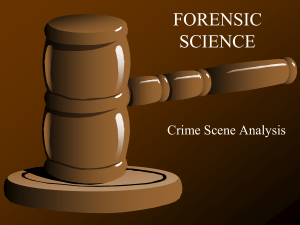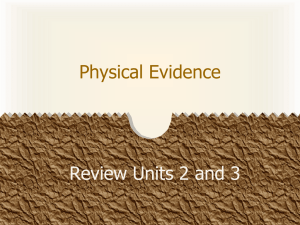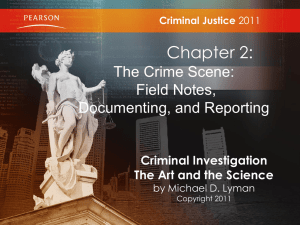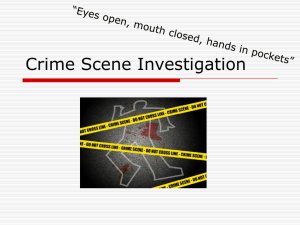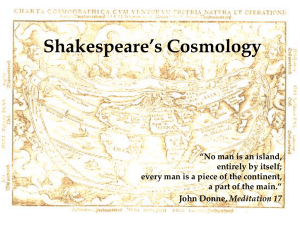The exchange of materials between two objects that come
advertisement
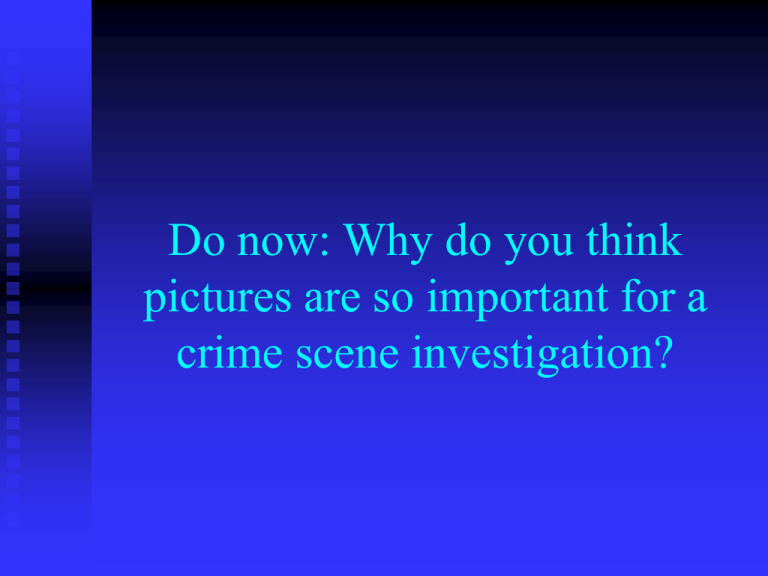
Do now: Why do you think pictures are so important for a crime scene investigation? THE CASE: A man works with the police to identify criminals. His help is invaluable even when he hasn’t witnessed a crime. Many of the criminals he identifies are never caught, but the police continue to ask the man for help. Coincidentally, the man’s first name describes what he does to help the police. THE MYSTERY: What is the man’s first name and what is his occupation? CLUES: The man’s name is not unusual. The man is on the police payroll. The man works with his hands and listens carefully to what other people have to say. The man is a trained professional, but also draws on natural talent. The man might share his name with the whole department. The man has a 3 letter name. First On The Scene Aim: How does Locard’s Principle Apply to the Crime Scene? Ripples in a pond are like traces left at the scene of a crime, they are produced as a consequence of an action. They can be far-reaching and often misleading. The scientist must interpret them correctly for their true significance. The exchange of materials between two objects that come into contact with one another. Every Contact Leaves a Trace “Every Contact Leaves a Trace.” Sir Edmond Locard (1877-1966) Sherlock Holmes of France Created a very simple idea, that while obvious to us now, was (and still is) quite powerful to the science of Forensics. Being able to find the “trace” is only limited by our abilities, knowledge, and degree of refinement of techniques & equipment. Forensic Science: can be defined as any science as it relates to law. Because of this, any science can be a “Forensic” science. 1. 2. 3. Crime Scene Processing Protocol Great care must be taken in order not to contaminate the crime scene. Locard’s Exchange principle state that: When a person has contact with someone or something, that person always leaves something behind. It may be a hair or a skin cell, but something is there. Basics of crime scene processing: 1. INTERVIEW 2. EXAMINE 3. PHOTOGRAPH 4. SKETCH 5. PROCESS Interview: The crime scene technician must interview the first officer at the scene or the victim to ascertain the "theory" of the case. Examine: Examine the scene to identify possible items of evidentiary nature, identify point of entry and point of exit, and getting the general layout of the crime scene. Photograph: Photographing the crime scene to record a pictorial view of what the scene looks like and to record items of possible evidence. Crime scene photographs are generally taken in two categories, overall views and items of evidence. Sketch: A rough sketch is completed by the crime scene technician to demonstrate the layout of the crime scene or to identify the exact position of the deceased victim or evidence within the crime scene. Process: The crime scene technician will process the crime scene for evidence, both physical and testimonial evidence. It is the crime scene technicians responsibility to identify, evaluate and collect physical evidence from the crime scene for further analysis by a crime laboratory. Chain of evidence: An unbroken chain of events regarding all evidence collected. This includes the location of all evidence from the time collected until submitted in court as well as the person responsible for the evidence. 1. Do not move anything 2. Take measurements in order to complete a detailed, scaled sketch. Include the scale on the drawing 3. Record the evidence you would like to see in the future. You may label any evidence with a note card or record the number if a note card is already in place. 4. Request additional photographs. 5. Be aware of EVERYTHING. Use your best skills of observation. Personnel Duties & Responsibilities Team Leader Assumes control at scene, conducts initial walkthrough, determines search patterns, designates individuals for jobs Photographer Sketch Artist Evidence Recorder & Custodian Maintain logs & proper packaging Specialists Forensic Anthropologist - Blood Spatter Analyst Bomb Technician - Medical Examiner - Entomologist Odontologist - Engineer - Latent Print Examiner - Ballistics - Arson - Impression Expert Case Study How can Physical Evidence point investigators in the right direction? “Eyewitness” accounts may not always be truthful!


